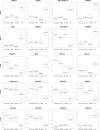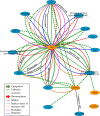Transcriptome Sequencing of Peripheral Blood Mononuclear Cells from Elite Controller-Long Term Non Progressors
- PMID: 31582776
- PMCID: PMC6776652
- DOI: 10.1038/s41598-019-50642-x
Transcriptome Sequencing of Peripheral Blood Mononuclear Cells from Elite Controller-Long Term Non Progressors
Abstract
The elite controller (EC)-long term non-progressor (LTNP) phenotype represent a spontaneous and advantageous model of HIV-1 control in the absence of therapy. The transcriptome of peripheral blood mononuclear cells (PBMCs) collected from EC-LTNPs was sequenced by RNA-Seq and compared with the transcriptomes from other phenotypes of disease progression. The transcript abundance estimation combined with the use of supervised classification algorithms allowed the selection of 20 genes and pseudogenes, mainly involved in interferon-regulated antiviral mechanisms and cell machineries of transcription and translation, as the best predictive genes of disease progression. Differential expression analyses between phenotypes showed an altered calcium homeostasis in EC-LTNPs evidenced by the upregulation of several membrane receptors implicated in calcium-signaling cascades and intracellular calcium-mobilization and by the overrepresentation of NFAT1/Elk-1-binding sites in the promoters of the genes differentially expressed in these individuals. A coordinated upregulation of host genes associated with HIV-1 reverse transcription and viral transcription was also observed in EC-LTNPs -i.e. p21/CDKN1A, TNF, IER3 and GADD45B. We also found an upregulation of ANKRD54 in EC-LTNPs and viremic LTNPs in comparison with typical progressors and a clear alteration of type-I interferon signaling as a consequence of viremia in typical progressors before and after receiving antiretroviral therapy.
Conflict of interest statement
The authors declare no competing interests.
Figures







References
-
- Collaborative Group on AIDS Incubation and HIV Survival. Time from HIV-1 seroconversion to AIDS and death before the widespread use of highly active anti-retroviral therapy: a collaborative re-analysis. Lancet. 355, 1131–1137 (2000). - PubMed
-
- Okulicz JF, et al. Infectious Disease Clinical Research Program (IDCRP) HIV Working Group. Clinical outcomes of elite controllers, viremic controllers, and long-term nonprogressors in the US Department of Defense HIV Natural History Study. J Infect Dis. 2009;200:1714–1723. doi: 10.1086/646609. - DOI - PubMed
-
- Saksena NK, Rodes B, Wang B, Soriano V. Elite HIV controllers: myth or reality? AIDS Rev. 2007;9:195–207. - PubMed
Publication types
MeSH terms
LinkOut - more resources
Full Text Sources
Medical

